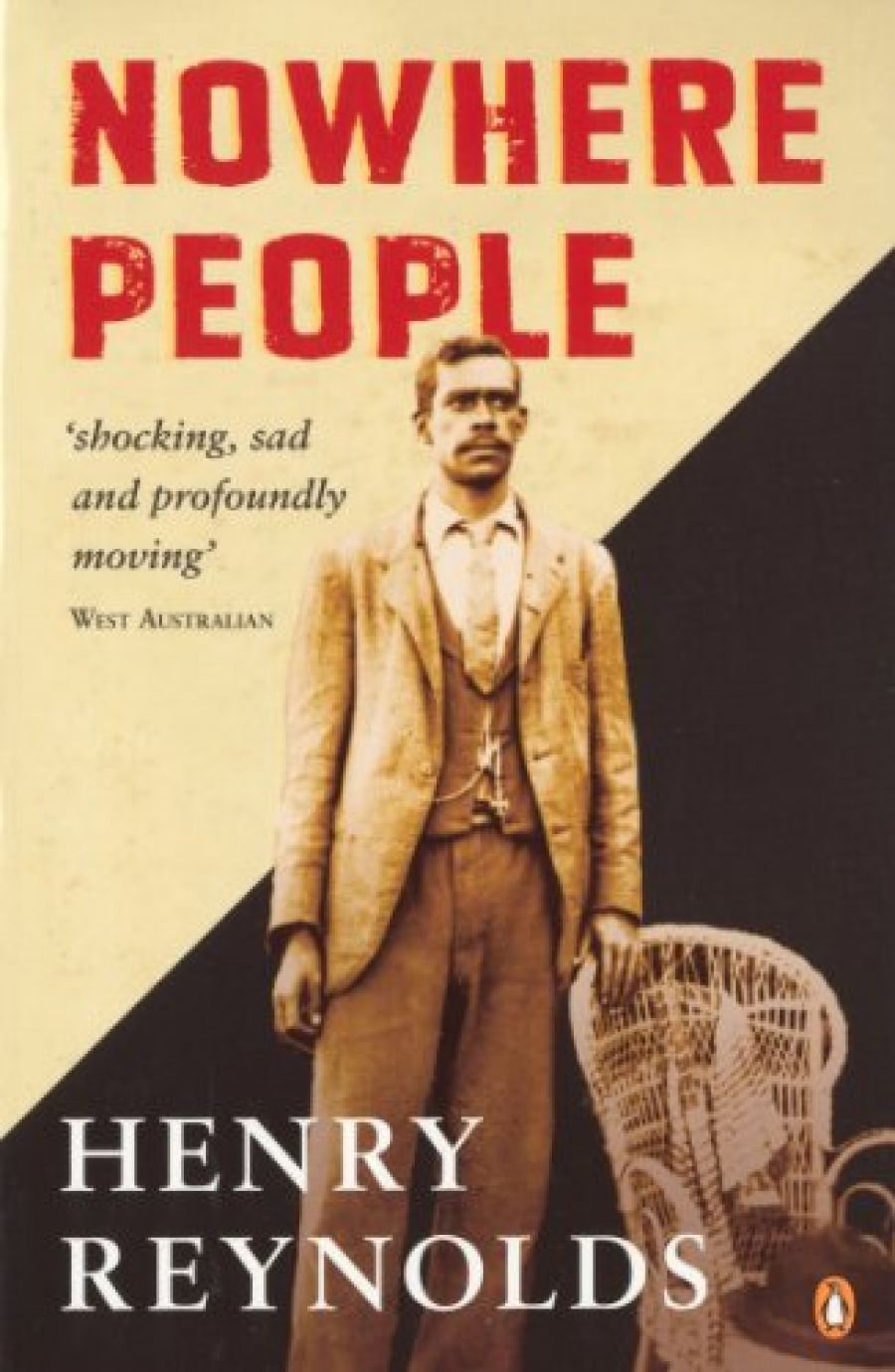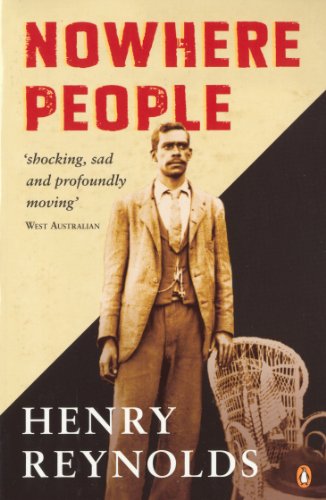
- Free Article: No
- Contents Category: Australian History
- Custom Article Title: Evolutionary politics
- Review Article: Yes
- Article Title: Evolutionary politics
- Online Only: No
- Custom Highlight Text:
In 1936, West Australian MP Leslie Craig stated in parliament that the (then) current figure of Aboriginal ‘half-castes’ in Australia – approximately 4000 – would soon number 40,000 if something were not done to stem the tide of this growing problem. Seventy years later, in 2006, a federal member of parliament has suggested that Australia is in danger of ‘aborting itself out of existence’ and becoming ‘a Muslim nation in fifty years’ time’ – and this only a few months after the Cronulla race riots. It is clear that race-based fears are still prevalent in our predominantly white Australia. Henry Reynolds’s latest book, Nowhere People – like most of his books – is as much an analysis of our contemporary society as it is an historical examination of how international theories of race shaped Australia’s identity over the past 218 years.
- Book 1 Title: Nowhere people
- Book 1 Biblio: Penguin, $29.95 pb, 305 pp
- Book 1 Cover Small (400 x 600):

- Book 1 Cover (800 x 1200):

Christian theology underpinned these positions. While the monogenesists claimed that we are part of the one species because we are all descendants of Adam and Eve, the polygenesists argued against this by claiming that there are far too many racial variations to be accounted for in the 6000 years since God supposedly created the universe.
On the topic of miscegenation, however, there was a strained consensus between these views, albeit for superficially different reasons. For the polygenesists, producing offspring between what were perceived as different races was an abomination, akin to bestiality. For the monogenesists, although their view admitted that biologically there was little difference between different ‘races’, such that cross-breeding was not considered to have many deleterious physical effects, it was still considered to be detrimental to the continuation of European culture. In this, both monogenesists and polygenesists shared a similar theologically based moral vision of race. The white European is good, and the further away from this centre of civilisation, and the darker your skin, the less good you are perceived as being. This obviously did not bode well for Australian Aborigines.
By the time Darwin appeared in the late 1800s, science had replaced theology as the recognised framework within which theories of race could be articulated. The great chain of being had now been replaced by peoples assuming their place in the evolutionary arc. ‘It was no longer a matter of being higher or lower on a chain of being,’ Reynolds states, ‘but being more or less recently evolved, being archaic or modern, being in an evolutionary sense closer or more remote from man’s primate cousins.’ In the early twentieth century, more sophisticated techniques had been developed, more thorough experiments had been conducted, and more detailed statistics gathered, all of which corroborated, and in turn was seen as justifying, a natural hierarchy which saw the European at its peak. The Australian Aborigine – used as a specimen – was present in all of these works, ranked on the lowest rung, beneath Asians and Africans. ‘Throughout the nineteenth century and the early twentieth century the Aboriginal people featured in almost every ethnographic and anthropological theory developed in Europe and the United States,’ Reynolds states. ‘Indeed, they were the zero from which anthropologists and ethnographers had “long reckoned our intellectual progress upward”’ (Reynolds is citing US scientist, Edward East, 1923).
Australia, then, became the unique site where the ‘highest’ and the ‘lowest’ forms of the human species were in competition for the same living space. It was thought that the ‘full-blooded’ Aborigine, being on the lowest stage of evolution, was ready for extinction. Their passing was seen as inevitable, and necessary in order to clear the way for a White Australia. This transition should, in theory, have been relatively seamless, except for the increase in the ‘half-caste’ population. To begin with, the fate of these people was also accounted for by the prevailing theories of race: the half-caste, containing the worst moral and physical traits of its parents’ races, would present only a temporary problem, a side symptom that would disappear with the eventual extinction of the Aboriginal race. For a while, white Australian scientists and politicians preferred to espouse the inevitabilities of the theory rather than confront the reality of the situation. Eventually, it could no longer be denied that the half-caste population was increasing. Moreover, the full-blooded Aborigines were not completely dying out, either. What had been seen as a scientific curiosity, an historical and evolutionary step, was now perceived as a political problem.
The prescriptive aspects of these scientific theories of race were henceforth translated into institutionalised practice. This resulted in the implementation from 1900 to 1960 of a raft of policies, the aim being to contain, control and diminish Aboriginal Australia, and to supplant it with a White Australia. The main target of these policies was this burgeoning half-caste population, which Reynolds calls Australia’s ‘nowhere people’. ‘Half-castes,’ he argues, ‘were not merely individuals who exacerbated a perceived social problem; they were also a threat to the idea of a homogeneous White Australia. To miss this part of the story is to totally misunderstand it. And standing behind White Australia itself was the imposing range of racial ideas that dominated scientific and sociological thought in all parts of the Western world before World War II.’
Most discussion of these policies, and their effects on the character of our nation, are by now familiar. However, Reynolds provides a fresh analysis of them, by placing this discussion within an international context. ‘Much of the recent debate about these policies has suffered from a lack of international perspective,’ he states. ‘One side treats Australia as though it was uniquely racist. The other believes that racism had very little to do with what was a humanitarian project and depicts participants as though they lived in sealed containers of virtue, cut off from the most powerful intellectual currents of the time.’
It would be possible, of course, to expand the background of this book, beyond the topic of race; the intellectual history Reynolds explores, and rightly criticises, is one that stretches across all aspects of our culture. There is a worrying tendency across humanities-based research at present that uses scientific discourse as a model of analysis, even at the same time as it criticises such scientific discourse (such as the erroneous theories of race examined in this book).
It allows the practitioner to pass judgment on others, while both removing oneself from that judgment, and alleviating responsibility for the consequences of that judgment. This scientific moralism, of course, is a legacy of the earlier theological discourse that science purported to have left behind. It is simply a way for dominant individuals and groups to justify their dominance, and provide ways to maintain it.
Reynolds traces this development (or lack thereof) in the debates concerning race, from the monogenesists and polygenesists, through to the Darwinists, and later social Darwinists and their eugenicist heirs. Such moralism is present today – especially on the question of race – even though scientific justifications for it have been removed, and can be found in more modern political and social discourse, in phrases such as ‘our way of life’.
In a social environment where such moralism has coincided so greatly with the national character, with what it means to be ‘Australian’, where any deviation from this is seen as ‘un-Australian’, voices like Henry Reynolds’s are even more necessary.


Comments powered by CComment